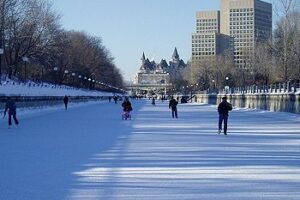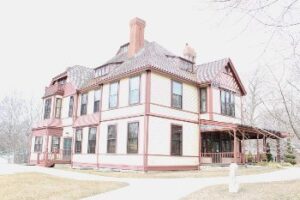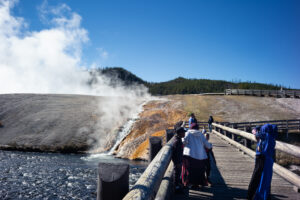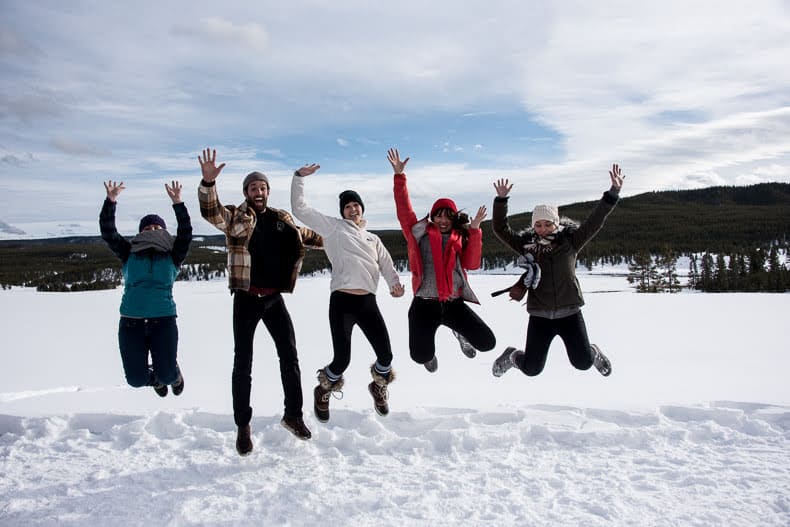
Winter in Yellowstone – Silence and Solitude in Abundance!
By Donnie Sexton
An overpowering stillness surrounds me.
The only thing I hear is the crunching of the snow beneath my feet and my labored breathing, having hiked around the Old Faithful area in Yellowstone National Park for a solid 45 minutes in cold
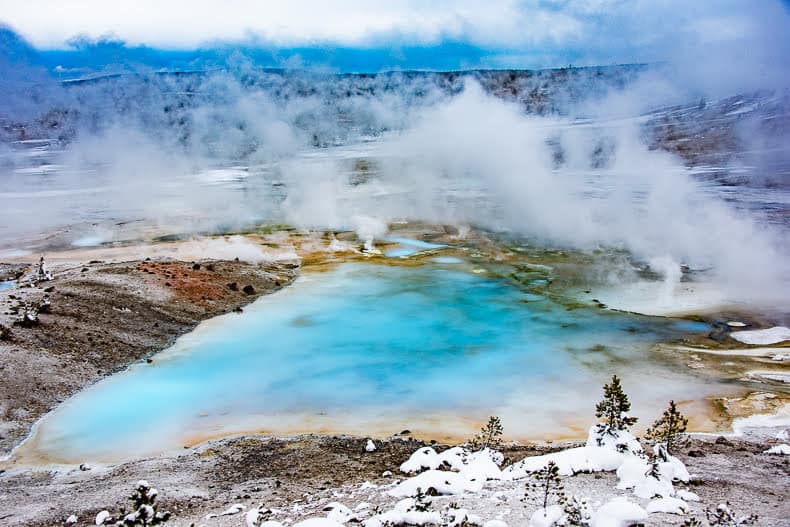
weather. All that stuff that normally clutters my mind on an hour-by-hour basis has taken a back burner to the steaming landscape, the rippling Firehole River and endless animal tracks punched into the snow. Yellowstone has me in her grip.

Our Nation’s Oldest Park
Yellowstone, the first and oldest national park in the US, sees way too much love from visitors in the summer. Over 4,250,000 visitors made their way to Yellowstone in 2016, and that number continues to increase.
In the heat of summer, it can be frustrating to find a parking spot open in the many pullouts that provide access to the natural attractions. But come winter, with roads closed, the crowd scene is all but gone.
If you’re willing to put in the effort it takes to explore the park in the offseason, you’ll find yourself in an otherworldly place steeped in beauty and rich in wildlife.
Exploring the Heart
One road remains open in Yellowstone year-round, and that is the section from Mammoth Hot Springs at the north entrance to the tiny hamlet of Cooke City, Montana. From the comfort of your car, you’re likely to pass by herds of bison in Lamar Valley. This stretch is also a favorite for spotting the wolves of Yellowstone.
When you see a few cars and people out with huge spotting scopes, you can bet they are focused on a wolf pack.

But I wasn’t about the drive. I wanted to get into the heart of Yellowstone, and in winter, that’s only possible via snowcoach or guided and non-guided snowmobile tours. There is something to be said about a ride in a warm snowcoach sans the bulky winter clothing, helmet, and clunky boots needed on a snowmobile.
So, I opted for the snowcoach tour, starting at Mammoth Hot Springs, and day-tripping to the Snow Lodge in the Old Faithful complex for an overnighter. Like all other winter visitors to Yellowstone, I was hoping to see plenty of critters amid the wintery landscapes.
Bring On the Bison
Once aboard the snow coach, we bounced along through forested land with sweeping views of distant mountains alternating with snow-laden meadows. At one turn, a herd of frosted bison came ambling down the road toward us and passed mere inches from my window. Score! I couldn’t have asked for a more perfect shot of these massive creatures!
Norris Geyser Basin
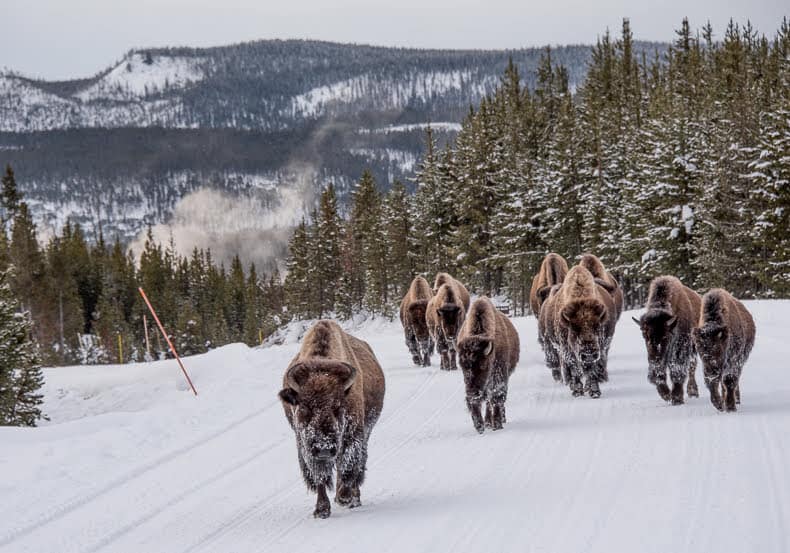
The first stop was Norris Geyser Basin, where we negotiated the slippery boardwalks through this geothermal area thought to be over 115,000 years in the making.
Norris is also the hottest thermal area in the park, with recorded temps of 459 degrees Fahrenheit. The colors at Norris are more varied than a giant sized box of crayons.
Deep turquoise pools to brilliant green mats, along with rivers of gold, ochre and every possible shade of brown were fascinating. A pungent sulfuric smell, akin to rotten eggs, added to the sensory experience of Norris.
Grand Canyon of the Yellowstone
From Norris, we headed to the Grand Canyon of the Yellowstone. Here we would see the iconic Lower Falls of the Yellowstone River, likely the most photographed formation in the Park.
The River typically plunges 308 feet into a deeply chiseled canyon, but in winter, it had turned into a massive green tinted icicle.

The Grand Canyon with its salmon-colored walls dusted in snow cradles the Yellowstone River. This body of water remains the longest undammed river in the US. I was feeling mighty small standing at the edge of this immense landscape.
Wolf Sighting

All the snowcoach drivers stay in touch via radio to report anything noteworthy. The excitement was building as news crackled through of a bison kill with a pack of wolves on it. This was that killer shot I was hoping to get.
Sure enough, we rounded the corner to see both snowcoaches and snowmobiles stopped, spotting scopes set up and people eyeing something barely visible to the naked eye.
Six wolves were feasting on a carcass all right. Everyone was so excited to see wolves, except for me. That darn kill was barely, I mean barely visible from the road. Sadly, there was no need to pull out the camera.
Old Faithful Being Faithful
By late afternoon, we pulled into the Old Faithful complex. Old Faithful, the granddaddy of all geysers, was due to erupt about an hour after our arrival. She blows about every 90 minutes or so. Except for our party of six, the place looked deserted.
To kill time, I wandered off alone on a snowy path to explore and found myself enveloped in stillness.
In those moments of solitude, I was overcome with an appreciation for nature – every track in the snow, every bit of rising steam from a vent hole, the undulating patterns of the Firehole River — seemed magnified in my senses. I was truly “in the moment” and the satisfaction was almost surreal, having all my senses focused completely on Yellowstone.

I found my way back to watch Old Faithful start hissing and spitting up and finally erupting some 130 feet into a bluebird sky. I had no idea where the rest of my party was. Seems like that geyser was putting on a three-minute show just for me.
A New Day and New Sights
The next morning, a new day brought softly falling snow from gray skies. It was back in the snow coach now headed towards the parks’ west entrance at West Yellowstone.
Along the way, we stopped to explore lower Geyser Basin, where all sorts of geysers and fumaroles were spitting and spewing, along with mud pots gurgling like a pot of chocolate boiling on the stove.
At one point, I came eye to eye with a coyote on the boardwalk, who like a gentleman, stepped off and let me pass while he walked to the side. We counted 152 bison on the last leg of our tour, some at close range swinging their large heads back and forth pushing the snow away to reach the grass.
In The Moment
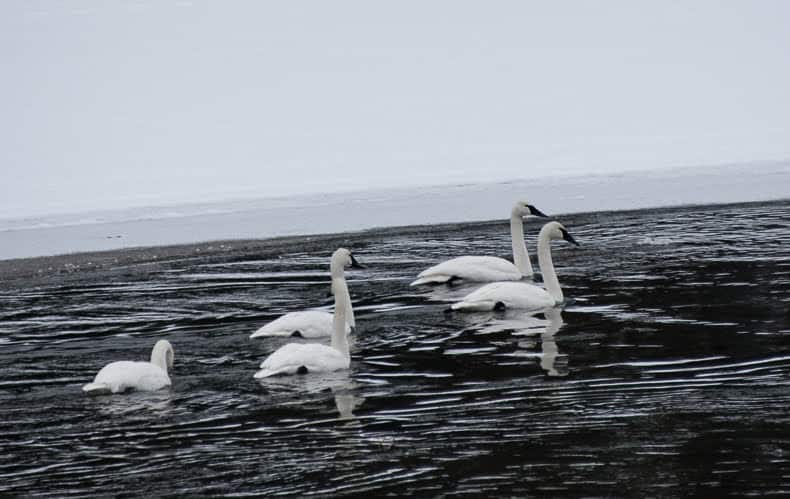
Once back into civilization in West Yellowstone, I quickly reverted to my daily life of checking messages on my phone and responding to emails. I used to think that working at the remote Snow Lodge all winter would be too desolate and lonely for me.
Yet everyone I met there relished their job. Perhaps they are the lucky ones – living in the moments of stillness and tranquility that the park affords during the winter and getting by without so much clutter of the mind.
Yellowstone Details
The winter season for park tours starts when enough snow has accumulated, usually by mid-December and ends in mid-March. The only winter lodging available within the park is at Mammoth Hotel (which will close for the 2018-19 winter season for renovation) and the Snow Lodge at Old Faithful.
The upscale Snow Lodge has a serious degree of coziness. A large lobby with a roaring fire, restaurant, bar and gift shop with rentals of cross-country skis and snowshoes covers the bases for a great visit. There are plenty of accommodations just outside the park both in the towns of Gardiner and West Yellowstone, Montana.
A list of these businesses that provide guided snow coach and snowmobile tours can be found at Yellowstone National Park.
- Sorrento, Perched on the Amalfi Coast - November 14, 2024
- Sumba, Java, and Komodo by Phinisi Boat - August 16, 2024
- Memorable Singapore Street Food - July 28, 2024



